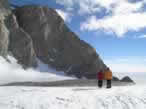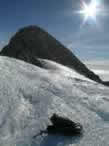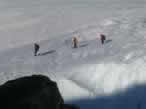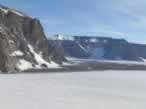The Tuning Nunatak, pt. 1
Today was the first day of fieldwork – essentially a shakedown for testing our equipment, and become familiar with sampling. It took us a while to get ready this morning… I arose and got the water piping hot for drinks and oatmeal, and the rest shortly followed as the sounds of my clanging must’ve indicated the availability of warmth and sustenance. The weather was perfect, with temperatures just around freezing, no wind, few clouds, and perfect visibility and surface definition. We set out westward toward the large bluffs of Darling Ridge, and a small speck on the horizon known as the ‘Tuning Nunatak.’
The going is slow over the snow, as the wind-scoured, sastrugi-laden surface produces countless obstacles to navigate in the rather light Tundra II ski-doos. Laying out the flag route, it took us a while to approach the bluffs – enhancing our already eager anticipation of what geological clues they might provide. We finally arrived at the ‘wind-scoop,’ which is a deep mote carved out of the ice by wind and radiant heat from the rocks of the underlying mountain. This one was approximately 15 meters high, and the blue-ice below the large escarpment was concentration glacial erratics into a significant ice-cored lateral moraine. The ice cliffs underfoot, the moraine below, the towering granite cliffs soaring high above, and the impressive network of crevasses propagating through the ice were all such an impressive sight!
We drove a bit further to scout out a route into the moraine for future use, but were diverted by a series of large crevasses. Following the north-south trending crescentic crevasses, we wound our way to Tuning Nunatak, a structure worthy of exploration on such a perfect day. We all got ready, and as I went to reach for my bag of mountaineering gear, with crampons and a harness, and I was shocked to find that it wasn’t on the sled! The true meaning of ‘shakedown’ reared its ugly head, and I had to scold myself for such ineptitude on the first day! This, of course, presented an obstacle for me, since I had to cross a ridged, heavily crevassed region of blue ice to gain access to the Nunatak. I was certainly kicking myself for forgetting the bag, and the thing I had looked forward to the most, walking over glacial ice, was now something I could not easily accomplish – and had to admit to my superiors.
Luckily, I had earlier taken the precaution, and placed an alternate pair of ice-gripping wire that could be stretched around the bunny boots. This gave me a surprising amount of traction, and I ended up getting by just fine even on the steep ice. However, I was very lucky, and definitely learned a lesson for the future – don’t forget anything!!
However, ironically, those who were responsible and remembered their gear actually had worse problems. Here I am referring to Sujoy, whose crampons would not stay on no matter how well you tightened the straps. He ended up having to use a similar pair of cleats for his bunny boots. If I had remembered my gear, I am certain I would’ve had the same problem as he, as we both had crampons meant for the Bunny Boots, which are not suitable for reliable ice-walking. From now on, I will attempt to wear my hiking boots for such endeavors, with a pair of reliable crampons. Hopefully they will not get too cold.
Once on the Nunatak, we found several interesting features. The entire peak is composed of a fine-grained granite, but angular pieces of pegmatitic granite were perched in various places, along with foreign shales comprising most of the thin matrix occupying the nooks and cranies of the rock. The top also was polished, possibly due to old glacial exploitation of a slickensided joint-face.
We sampled two erratics and a mafic enclave in the bedrock. It was
a good introduction to sampling procedure, where we first measured
the
amount
of the sky-field
that is shielding the sample from cosmic rays (in the case, the
primary shielding was caused by Darling Ridge to the south).
Then, elevation,
lithology, location
coordinates, all accompanied by a sketch of the sample in situ
were recorded. A sample bag was then labeled, the outcrop photographed,
and finally
removed the sample using a rock hammer. I worked on the mafic enclave,
while the
others chose granite erratics. This rock type is significant because
it may contain
clinopyroxene, which can be used in small amounts to obtain exposure
age using the amount of 3He. I’ll try to detail the procedure later.
We then left for home, and ate a late-night fish dinner. It was
a successful first run, but we definitely encounter room for improvement
(me in
particular). Hopefully tomorrow will yield similar weather so we
can explore the moraines
around Discovery Ridge and Treves Butte!




